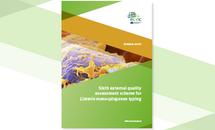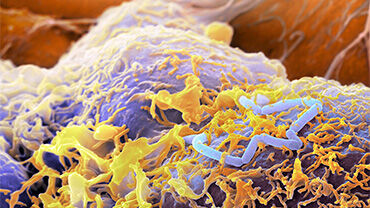Ninth external quality assessment scheme for Listeria monocytogenes typing
This report presents the results of the ninth round of the external quality assessment (EQA-9) scheme for Listeria monocytogenes (L. monocytogenes) typing, organised for national public health reference laboratories (NPHRLs) providing data to the Food- and Waterborne Diseases and Zoonoses Network (FWD-Net), managed by ECDC.
Executive Summary
This report presents the results of the ninth round of the external quality assessment (EQA-9) scheme for Listeria monocytogenes (L. monocytogenes) typing, organised for national public health reference laboratories (NPHRLs) providing data to the Food- and Waterborne Diseases and Zoonoses Network (FWD-Net), managed by ECDC. Since 2012, the Section for Foodborne Infections at Statens Serum Institut (SSI) in Denmark has arranged the EQA under a series of framework contracts with ECDC. EQA-9 involves serotyping, and molecular typing-based cluster analysis.
Human listeriosis is a relatively rare but serious foodborne disease with a European Union (EU) notification rate of 0.49 cases per 100 000 population in 2021 [3]. Between 2017 and 2019, the number of human listeriosis cases in the EU increased, while 2020 saw the lowest number of human cases ever reported, due to the impact of the COVID-19 pandemic and the withdrawal of the United Kingdom from the EU. However, the number of cases did not return to the pre-pandemic level in 2021.
Since 2007, ECDC has been responsible for EU-wide surveillance of listeriosis, including facilitating the detection and investigation of food-borne outbreaks. Surveillance data, including certain basic typing parameters, are reported by European Union/European Economic Area (EU/EEA) countries to The European Surveillance System (TESSy). Since 2012, the EQA scheme has covered molecular typing methods used for EU-wide surveillance.
The objective of this EQA is to assess the quality and comparability of typing data reported by NPHRLs participating in FWD-Net. Test strains for the EQA were selected to cover strains that are currently pertinent for public health in Europe and to represent a broad range of clinically relevant types of invasive listeriosis. Seven test strains were selected for serotyping/grouping and molecular typing-based cluster. An additional ten sequences were included for the molecular typing-based cluster analysis. Twenty-one laboratories signed up and 20 completed the exercise, with one laboratory unable to setup the WGS for L. monocytogenes before the deadline for submission. This represented an increase of three laboratories compared to EQA-7 and EQA-8. The majority of participants (15/20; 80%) completed the full EQA scheme.
In total, 18 (90%) laboratories participated in the serotyping part. Molecular serogrouping results were provided by 17 of 18 (94%) participants. Four participants performed both conventional serotyping and molecular serogrouping and one only performed the conventional serotyping. The average performance for molecular serogrouping was high, with 96% correct results. For the conventional method, 80% of the participants correctly serotyped all seven test strains. One participant mistyped five of the seven strains in the conventional serotyping, but achieved 100% correct results in the molecular serogrouping, which they performed for the first time. Since the first EQA in 2012, the trend has been towards replacing conventional serotyping with molecular serogrouping, with strong performance; however, in EQA-9 three participants using WGS incorrectly determined the serogroup for one of the ‘repeat’ strains.
Of the 20 laboratories participating in the EQA-9, 17 (85%) performed molecular typing-based cluster analysis using a method of their choice. The idea of the cluster analysis part of the EQA was to assess the NPHRLs’ ability to identify a cluster that was genetically closely related − i.e. to correctly categorise the cluster test strains regardless of the method used, rather than being able to follow a specific procedure.
The cluster of closely-related strains was pre-defined by the EQA provider using WGS derived data. Therefore, as expected, the correct cluster delineation was difficult to obtain using less discriminatory methods (e.g. pulsed-field gel electrophoresis (PFGE)). Neither of the two participants that used PFGE identified the cluster correctly and they could not include the sequences provided in their analysis. Sixteen laboratories performed cluster analysis using WGS- derived data. In general, performance was strong, with 81% of the participants correctly identifying the cluster of closely-related strains when assessing good quality data (QC-status A).
The modified sequence (strain17, cluster strain with coverage reduced to approximately 94%) did interfere with the analysis for some participants, who incorrectly found that this strain was genetically too distant to be part of the cluster. This EQA clearly shows that the effect of differences between the approaches and schemes used by the participants is amplified when assessing data of non-perfect quality. Each laboratory should test and find standard Quality Control (QC) thresholds that work for their approach and scheme. The laboratories assigned a different QC- status for some of the modified strains, and the results affected the analysis and conclusions.
All participants were able to recognise the modified sequence with very reduced coverage; however, some participants could not recognise the sequence with contamination and the sequence with a mix of two different sequences types (STs). The preferred analysis method was the allele-based core genome multilocus sequence typing (cgMLST) used by 88% (14/16), while only 13% (2/16) used single nucleotide polymorphism (SNP). The most widely used scheme for the EQAs was the Ruppitsch (cgMLST) (11/15), while the Pasteur scheme (cgMLST) was used by 31% (5/16) of the participants in EQA-9. The conclusion from this EQA-9 was that cgMLST has a higher consistency than SNP analysis as the results were much more comparable.
The current EQA scheme for L. monocytogenes typing is the ninth EQA organised for NPHRLs in the FWD-Net. The molecular typing-enhanced surveillance system, implemented as part of TESSy, relies on the capacity of FWD-Net laboratories to produce sequences of good quality and comparable typing results for cross-border cluster detections. For five years, the public health institutes have had the possibility to routinely submit WGS variables for L. monocytogenes to TESSy to be used for EU-wide WGS-enhanced listeriosis surveillance. In addition to the WGS data submitted by the Member States for the listeriosis cluster detection, ECDC also collects and analyses sequence data during multi-country outbreak investigations that are primarily initiated by Member State public health institutes through EpiPulse.
A feedback survey was sent to assess the Listeria EQA scheme; the questionnaire contained questions related to accreditation and information on the individual report; 13/20 responded. The usefulness of the QC evaluation of participant-sequenced data and the helpfulness of including low quality data was appreciated by 100% of respondents.
Download








